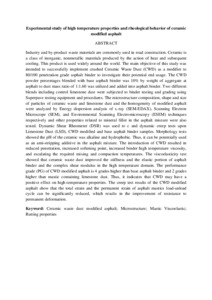Citation
Aburkaba, Eltaher Elzarroug and Muniandy, Ratnasamy
(2016)
Experimental study of high temperature properties and rheological behavior of ceramic modified asphalt.
Australian Journal of Basic and Applied Sciences, 10 (6).
pp. 150-161.
ISSN 1991-8178; ESSN: 2309-8414
Abstract
Industry and by-product waste materials are commonly used in road construction. Ceramic is a class of inorganic, nonmetallic materials produced by the action of heat and subsequent cooling. This product is used widely around the world. The main objective of this study was intended to successfully implement crushed Ceramic Waste Dust (CWD) as a modifier to 80/100 penetration grade asphalt binder to investigate their potential end usage. The CWD powder percentages blended with base asphalt binder was 10% by weight of aggregate at asphalt to dust mass ratio of 1:1.60 was utilized and added into asphalt binder. Two different blends including control limestone dust were subjected to binder testing and grading using Superpave testing equipment and procedures. The microstructure composition, shape and size of particles of ceramic waste and limestone dust and the homogeneity of modified asphalt were analyzed by Energy dispersion analysis of x-ray (SEM-EDAX), Scanning Electron Microscope (SEM), and Environmental Scanning Electromicroscopy (ESEM) techniques respectively and other properties related to mineral filler in the asphalt mixture were also tested. Dynamic Shear Rheometer (DSR) was used to c and dynamic creep tests upon Limestone Dust (LSD), CWD modified and base asphalt binder samples. Morphology tests showed the pH of the ceramic was alkaline and hydrophobic. Thus, it can be potentially used as an anti-stripping additive in the asphalt mixture. The introduction of CWD resulted in reduced penetration, increased softening point, increased binder high temperature viscosity, and escalating the required mixing and compaction temperatures. The viscoelasticity test showed that ceramic waste dust improved the stiffness and the elastic portion of asphalt binder and the complex shear modulus in the high temperature domain. The performance grade (PG) of CWD modified asphalt is 4 grades higher than base asphalt binder and 2 grades higher than mastic containing limestone dust. Thus, it indicates that CWD may have a positive effect on high-temperature properties. The creep test results of the CWD modified asphalt show that the total strain and the permanent strain of asphalt mastics load-unload cycle can be significantly reduced, which results in the improvement of resistance to permanent deformation.
Download File
![[img]](http://psasir.upm.edu.my/53920/1.hassmallThumbnailVersion/Experimental%20study%20of%20high%20temperature%20properties%20and%20rheological%20behavior%20of%20ceramic%20modified%20asphalt.pdf)  Preview |
|
Text
Experimental study of high temperature properties and rheological behavior of ceramic modified asphalt.pdf
Download (7kB)
| Preview
|
|
Additional Metadata
Actions (login required)
 |
View Item |

